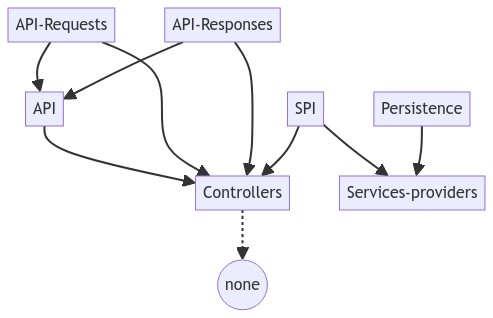-
Notifications
You must be signed in to change notification settings - Fork 7
Code structure
Open this project in an IDE, like IntelliJ.
- initial files provided by LHDI's Java Starter Kit in PR #8
- software changes in Current Software State
-
settings.gradle: includes subdirectories as Gradle subprojects -
build.gradlein the project root,api, andappsubdirectories -
buildSrcsubdirectory: LHDI Starter Kit provides Gradle plugins; details in the README.md - Run the software and browse to http://localhost:8080/swagger to see the OpenAPI spec
Based on build.gradle files in each directory, here's the rough subproject dependencies (based on PR #50):
-
app- main@SpringBootApplication-
api- annotated API, used to populate OpenAPI doc; defines request and response POJOs -
controller- defines@RestControllerclasses (which implement api classes) and@Mapperclasses (which convertservice.modelobjects from/to request/response POJOs)apiservice:providerservice:spi
-
persistence:model- defines DB@Entityclasses and DB query methods (the implementation of which is inpersistence:impl) -
persistence:impl- implements DBRepositoryinterfacespersistence:model
-
service:provider- implementsservice:spi; persistsservice.modelobjects to/from DB using@Entityclassespersistence:model-
service:spi- used by controllers -
tests-data-factory- provides factories used in tests
service:spi
-
UPDATE: has since been removed
Added in PR #63 as a separate container for Ruby services from the RRD prototype.
Contains the code for the abd_vro-service-ruby package (container image).
List the microservices (which each have an associated Gradle project):
- 2 python assessors
- 1 python pdf generator
- 1 Java client for LH API
svc-lighthouse-api - 1 Java client for MAS API
svc-mas-api(in development)
Since the Python microservices have common code, it is extracted into a shared library:
service-python/main-consumer.py
And we have our big services:
- Postgres +
db-init - RabbitMQ
- Redis
Plus we have our MVC layers initially set up by LH Starterkit:
-
apidefining VRO's API -
controllerfor the API -
persistence:modeldefining DB Entity classes -
service:dbfor DB interactions -
service:spicontaining Java interface and model definitions -
service:providercontaining Camel configurations
A shared folder where code for common (Java) libraries can be placed (so that the top-level directory isn't more cluttered):
lib-camel-connector-
domain(PR Move domain folder to new shared folder #551) - ...
There are tests in LayeredArchitectureTest to check for undesirable dependencies:
Rule 'Layered architecture consisting of
layer 'API' ('gov.va.starter.example..api..')
layer 'API-Requests' ('gov.va.starter.example..api..requests..')
layer 'API-Responses' ('gov.va.starter.example..api..responses..')
layer 'Controllers' ('gov.va.starter.example..controller..')
layer 'SPI' ('gov.va.starter.example..service.spi..')
layer 'Services' ('gov.va.starter.example..service.provider..')
layer 'Persistence' ('gov.va.starter.example..persistence..')
where layer 'API' may only be accessed by layers ['Controllers']
where layer 'API-Requests' may only be accessed by layers ['Controllers', 'API']
where layer 'API-Responses' may only be accessed by layers ['Controllers', 'API']
where layer 'Controllers' may not be accessed by any layer
where layer 'SPI' may only be accessed by layers ['Controllers', 'Services']
where layer 'Persistence' may only be accessed by layers ['Services']'
For more description, check out LHDI's doc on project structure.
